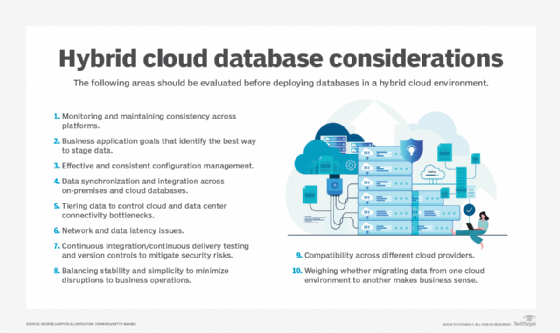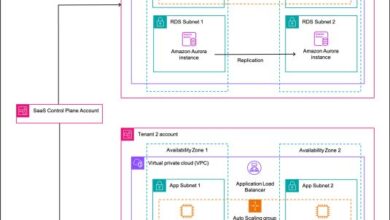Managing Databases in a Hybrid Cloud: 8 Key Considerations

Hybrid cloud architectures play a vital role in helping enterprises migrate safely to the cloud and provide a way to meet data governance and risk management requirements for data that must stay on premises. But moving applications and the databases that support them to even a hybrid cloud requires considerable planning and testing, plus ongoing management and monitoring.
In a hybrid cloud database environment, some data is stored and managed on-premises and some is moved to the public cloud. As a result, running databases in a hybrid cloud introduces new data management considerations that must be addressed to keep data secure, accurate and compliant with regulations while also ensuring it can be processed efficiently.
What is a hybrid cloud?
A hybrid cloud combines public cloud services with traditional enterprise IT infrastructure that’s typically set up as a private cloud. The enterprise IT aspect could include servers managed directly by an organization in its own facilities or colocated in a third-party data center shared with other users. Some applications are managed using familiar in-house IT processes, while others are managed through cloud-specific processes.
Hybrid cloud database deployments extend the same concept to the data itself. But the decision to go to a hybrid cloud database model should be driven by application and workload needs that call for databases to be on a hybrid cloud, said Yugal Joshi, partner at technology research and advisory services firm Everest Group. If that’s the case, hybrid architectures can provide complementary benefits to the underlying applications by streamlining access to required data.
Although they often provide lower costs and more flexibility than on-premises database systems, cloud database services aren’t practical for every enterprise or application. “With increased data scrutiny, strong data gravity, workload requirements on latency, licensing complexity and data decentralization, not every data can be put on one source such as public cloud,” Joshi said. “This is where a hybrid model can add value.”
Mike Fitzgerald, CIO advisory partner and global cloud consulting lead at Infosys Consulting, observed that hybrid cloud environments can have multiple permutations that shape database strategies, including the following:
Benefits of a hybrid cloud for deploying databases
The potential benefits of hybrid cloud database environments are like those of hybrid clouds for applications. Those benefits include the following:
- Provide access to automated cloud services. “By using a hybrid cloud to deploy databases,” said Alexander Wurm, an analyst at Nucleus Research, “organizations can reap the benefits of the modern cloud, such as regular updates and elastic scalability, without interfering with the security and reliability provided by existing on-premises infrastructure in support of mission-critical workloads.”
- Open up new technology options. Enterprises can also explore new options that weren’t practical with legacy database technology. If needs related to key variables such as security, performance, quality or cost change over time, more options are available to rebalance the portfolio, said Joshua Swartz, a partner in the digital transformation practice at management consultancy Kearney.
- Improve portability of data and application workloads. A hybrid cloud database approach also supports data and workload portability across multiple private and public cloud services. As a result, an organization can pick and choose how it coordinates database deployments to reduce costs, avoid vendor lock-in, and grow and shrink environments as workloads change. In addition, increased portability can make data recovery and business continuity planning easier as well as encourage experimentation and innovation.
What to consider when planning a hybrid cloud database strategy
Hybrid cloud architectures provide benefits that can unlock new opportunities to lower costs. However, they also introduce new security, performance, integration and data quality challenges that need to be initially addressed to maximize a hybrid cloud database strategy. IT teams, data managers and database administrators should consider the following issues before deploying databases in a hybrid cloud environment.
1. Monitoring databases and maintaining consistency
As organizations move workloads to hybrid cloud environments, they must focus as much attention on data as on applications. “The biggest challenge in managing databases in a hybrid cloud environment is monitoring and maintaining consistency across different platforms, as on-premise databases and cloud-based databases often require different management tools and metrics,” Fitzgerald said. He recommended that enterprises consider hybrid data operations, cybersecurity and tool compatibility.
Start by investing in unified monitoring tools that can monitor both on-premises and cloud databases, providing a single pane of glass to manage your entire database portfolio, Fitzgerald said. Also, standardizing database technologies can simplify management and potentially reduce the number of monitoring tools required. Similarly, automating routine tasks such as backups, patching and scaling reduces the complexity of managing databases in a hybrid environment. An MSP can often help monitor and optimize the overall performance of the hybrid infrastructure.
It’s crucial to understand the end-to-end workloads you’re putting in the hybrid cloud environment. Data management teams also need to investigate the compatibility of current and prospective tools. “Typically, an organization will use several data management tools and homegrown applications,” Fitzgerald said. Areas to consider include tools for database operations, cloud monitoring, observability, data security and compliance, cloud key management and hybrid cloud security.
2. Appropriate grouping of applications and databases
Focusing on business and application goals can help identify the best way to stage data to support different application requirements. “The movement of applications and databases requires the appropriate grouping of the applications and databases into logical units,” said Colin Dawes, CTO at managed service provider Syntax.
Creating these natural fault lines can help data management teams divide monolithic systems into manageable chunks. Getting this part of the process wrong, Dawes said, can create performance and stability issues that result in business stakeholders involved in the process rejecting it.
3. Configuration management
“One of the more unique and challenging aspects of managing databases in a hybrid environment is the inconsistency in configuration management,” said Randy Armknecht, managing director of enterprise cloud and global delivery at consulting firm Protiviti. While on-premises databases require configuration of the underlying OS and the database itself for performance, self-managed databases in the cloud also require configuring the cloud services.
Depending on the cloud provider, the specific configuration for optimizing the database also differs between on-premises and cloud-based instances. These configurations change again if a vendor-managed database as a service (DBaaS) offering is used instead of a self-managed IaaS one. Dealing with the complexity of location-dependent configurations isn’t core to the skill set of traditional DBAs and is a growing challenge as more and more find themselves managing such complex environments, Armknecht said.
A companion challenge is implementation and validation of database security controls. The technical specifics of how on-premises, self-managed IaaS and DBaaS deployments achieve common cybersecurity outcomes are different from a controls perspective. As a result, effective and consistent configuration management “is paramount to achieving vulnerability management and compliance objectives,” Armknecht said.
4. Data synchronization and integration
Synchronizing and integrating data across on-premises and cloud databases in hybrid cloud environments poses significant challenges due to differences in data formats, schemas and security requirements. “Ensuring data consistency and integrity during data transfers between these environments is crucial to avoid discrepancies and maintain business continuity,” said Mohammad Wasim, group vice president and Global AWS alliance lead at Publicis Sapient, a digital transformation consulting firm.
Wasim recommended using real-time data integration techniques to continuously synchronize data between on-premises and cloud databases. Technologies such as database triggers, change data capture tools and event-driven processing architectures can rapidly replicate data as it’s collected or updated. In addition, standardizing data formats, protocols and APIs across on-premises and cloud environments simplifies data synchronization processes. Ensuring compatibility between different databases and applications can also facilitate seamless data transfers.
However, data egress costs must be carefully considered as they can substantially affect expenses related to data transfers in hybrid cloud environments. These charges depend on the volume of data replicated between databases in a hybrid cloud. Effective controls must be established to manage data flows across costly channels.

5. Cloud and data center connectivity bottlenecks
One of the biggest challenges encountered by financial market data API provider Databento was bottlenecks between the cloud and its self-hosted infrastructure, CEO Christina Qi said. The company, which has a large hybrid cloud footprint with more than 20 PB of data storage, found it helpful to tier data to get the best of both worlds. For example, smaller databases accessed primarily by cloud applications are deployed in the public cloud. Larger databases requiring frequent access from outside the cloud, and a high volume of random IOPS are kept in Databento’s own environment.
But Qi also recommended organizations put on-premises database systems in a data center with cloud on-ramps that offer direct connections to cloud services through dedicated network links or virtual circuits. “This makes your self-hosted environment feel more like it’s part of your cloud infrastructure by ensuring you get consistent throughput and latency between the two environments over a private link and the cloud provider’s private backbone,” she said.
6. Network and data latency
A hybrid cloud database environment can also introduce network latency due to data transfers between different cloud service providers and the distance between physical resources. A hybrid approach typically results in longer routes and more network hops, which can add several milliseconds or even seconds to data transfers. Latency should be factored into the planning process, and decisions on the geographic regions where database systems are deployed might need to be revisited if it becomes an issue.
Configuration choices also need to be considered from a latency perspective when planning whether cloud and on-premises server nodes have a more active or passive role in clustered systems designed to support fault tolerance and high availability. For example, active-active cluster configurations with workloads distributed across multiple servers often have less competitive latency between private and public clouds, Wurm said. He added that active-passive configurations with standby backup nodes might be a better choice for asset-intensive organizations, such as ones with an abundance of edge data.
Organizations should think through latency issues in advance to determine the setup that fits a team’s skill set and what it’s trying to solve, said Marty Puranik, CEO, president and founder of cloud hosting services provider Atlantic.Net. For example, if an organization needs to keep a database local for performance reasons, it should consider the cloud side potentially just for data replication or backup. “The challenge happens with mission or feature creep, and eventually, you end up with a mediocre solution that may work, but no one is really happy with it,” he said.
7. Data security
Governing and protecting data must be part of a hybrid cloud database strategy since the complexity of hybrid cloud environments can increase potential attack surfaces, said Brian Platz, CEO and co-founder at blockchain database platform provider Fluree. “[It] is essential,” he explained, “to map out the architectural flow of data across all possible environments [as well as] put into place security and governance measures that account for data as it is managed, deployed, ported and virtualized across all possible scenarios.”
Organizations should consider using continuous integration/continuous delivery testing and version control to mitigate security risks. It might also be worthwhile to explore data-centric security governance that protects the data as it moves across various networks and clouds.
8. Balancing stability and simplicity
Any new infrastructure to store, transfer and manage data has the potential to create new points of failure. Organizations with hybrid clouds need to consider how to minimize disruptions to business operations when a database system or network goes offline. “Solving this is a bit like an insurance policy,” Swartz said. “One can absolutely create redundancy and fail-safe mechanisms, but the costs are quite high.” The approach most companies follow is to tier data based on business criticality and provide the costliest redundancy for only the most critical data.
Provisioning for the work needed to integrate multiple systems is also a must. Every additional system or database brings another interface for integration with core applications and systems. Developing an architecture with fewer interfaces can lower management risk.
Managing a hybrid cloud environment can be far more complex and drive higher costs, compared to a cloud-only or on-premises approach, Swartz said. Database changes, updates, patches and enhancements all require more extensive and elaborate planning, testing and monitoring to avoid creating a domino effect of compatibility issues.
9. Compatibility across clouds
Another unique challenge when managing databases in a hybrid cloud is ensuring compatibility across different cloud providers, said Juan Orlandini, North America CTO and distinguished engineer at systems integrator Insight Enterprises. To address this, he recommended businesses normalize capabilities to minimize the need for extensive rewrites when migrating workloads between clouds.
Orlandini has also found it helpful to invest in platform engineering efforts. For example, open source frameworks such as Backstage can create a consistent development experience to help teams ensure cost controls, availability and mobility in a hybrid cloud environment.
10. Data migration
Organizations should also weigh whether migrating data from one cloud environment to another makes business sense, said Sharad Varshney, CEO at data catalog and data governance software vendor OvalEdge. Ultimately, the task is complicated and, if not managed correctly, can lead to costs spiraling out of control.
If a company does intend to commit to a data migration strategy, Varshney added, it should shift its data assets to as few source systems as possible. That will help simplify the architecture and mitigate the possibility of a data breach or other errors through bad practices, he said.
Varshney has found that many cloud environments use similar underlying processes and interoperability between them is relatively straightforward, although not standardized. However, adapting cloud environments to on-premises IT infrastructure in a hybrid approach can be a real challenge, he said. Senior-level technicians are often required to sort out the details.
Varshney also recommended that organizations choose from among the top three cloud platform providers — AWS, Microsoft Azure and Google Cloud — and only add new ones when business conditions require doing so. A step-by-step, incremental approach can better align the data migration process with business needs.
Editor’s note: This story was updated in May 2024 to reflect changing issues with hybrid cloud management and to improve the reader experience.
George Lawton is a journalist based in London. Over the last 30 years, he has written more than 3,000 stories about computers, communications, knowledge management, business, health and other areas that interest him.



